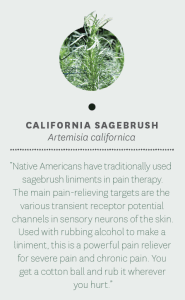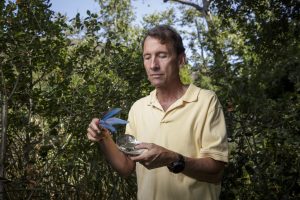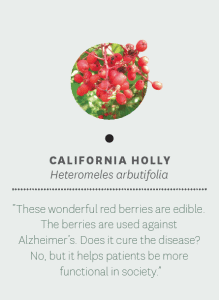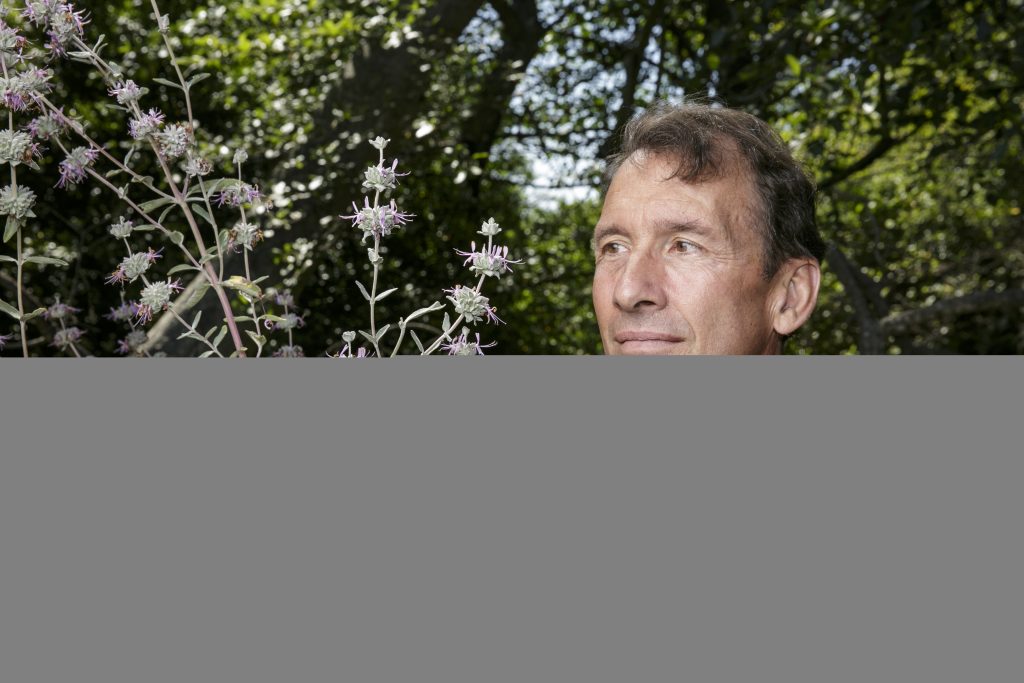As deaths from opioid abuse skyrocket, finding alternatives that offer real pain relief without the risk of addiction is a matter of national urgency. Enter pharmacologist James David Adams Jr., a USC School of Pharmacy Associate Professor who also happens to be a Chumash healer.
Although he doesn’t possess a drop of Native American blood, James David (Jim) Adams Jr.’s passion for native medicines flows in his veins. His ancestor, surgeon William Adams, was a Virginia settler who embraced the healing practices of native peoples back in 1635, when medical supplies from England were scarce. Those practices stayed in the family throughout the centuries, and Jim Adams used native remedies like sassafras tea for childhood aches and pains while growing up in Newport, Oregon. His professional interests also were spurred by observing his chemical engineer father as well as his mother, who suffered from chronic pain.
Today, Adams — who earned his PhD in comparative pharmacology and toxicology from the University of California, San Francisco, and has been on USC’s pharmacy faculty since 1987 — studies the active ingredients in medicinal plants native to Southern California, particularly those that provide pain relief. In addition to pharmacology and other topics, he teaches a course on complementary/alternative therapeutics and Chumash healing. “Opioids make pain worse,” he notes, describing opioid-induced hyperalgesia — an abnormally heightened sensitivity to pain.
To help counter the dangers of synthetic opioids, Adams also has continued his longstanding practice of taking USC pharmacy and medical students on hikes to such places as Eaton Canyon, Santa Fe Dam, Malibu Creek, Deukmejian Park and Claremont Hills Wilderness Park. At these inspiring locations, he reminds them to connect with nature in seeking ways to treat pain.

Adams’ goal is to conduct a clinical trial of a liniment that employs California sagebrush and rubbing alcohol, which he describes as a powerful reliever for severe and chronic pain. “Pain is felt in the skin, and you can effectively and safely treat pain by treating the skin,” he says. The Food and Drug Administration denied his previous application for a clinical trial, but that was before the current opioid crisis. “The dean is encouraging me to try again, and I’m planning to file the investigational new drug application in the next couple of months,” Adams says. If approved, the trial would be managed through the USC Pain Clinic on the USC Health Sciences Campus. It would recruit patients to use the California sagebrush liniment to treat their pain, in combination with oxycodone doses that would gradually be decreased.
The work is sorely needed. Sixty percent of all people over the age of 65 experience chronic pain but, Adams acknowledges, many resist topical pain relief treatments. He says some believe their pain is so severe it cannot be treated topically, while others allow pain to define their lives.
“The people who actually use the California sagebrush liniment get so much pain relief so quickly,” he says. “It’s a joy to see them liberated.”

Adams’ emphasis on Southern California plants’ healing potential also is unique. While more than half of today’s pharmaceuticals come from plants and other natural sources, they almost exclusively are derived from European and Amazonian species. Southland flora have been conspicuously overlooked. “There are dozens of plants in these hills right here that no one has ever investigated,” Adams says. No one in a lab coat, anyway.
When Adams first began his quest to explore the healing power of plants, he looked to traditional sources. For 14 years, he trained under renowned Chumash medicine woman Cecilia Garcia, who passed away in 2012. The two co-authored Healing with Medicinal Plants of the West, now in its third edition.
“To my knowledge, I am the only white person educated by a Chumash healer specifically to become a Chumash healer,” Adams says. In addition to developing a recognized cure for chronic pain, his dream is to educate others to become Chumash healers. “My teacher’s great-grandparents were professors at the Chumash medical school, until the U.S. Army shut it down in October 1855.” The school was located in the Cuddy Valley in Kern County, near Frazier Park, a mountain community in the Tejon Pass off the 5 Freeway.
Adams brings 21st century tools to the study of plants the Chumash have used for millennia. In his USC lab, specimens he gathers by hand undergo high-performance liquid chromatography, mass spectrometry and nuclear magnetic resonance spectroscopy. Botanists based in such places as China, France, Italy and Brazil travel to USC to work with him. Among the medicinal plants he and his research team — which includes USC undergraduates — study is the California holly (Heteromeles arbutifolia), also known as Toyon or Christmas berry. “No one has any clue what’s in this plant and how it works — even though we know it’s an Alzheimer’s treatment,” Adams says.

Incidentally, so abundant was California holly in the hills above Los Angeles that it gave rise to the name “Hollywood.” His study of the plant is fitting, given that his consulting expertise also has been called upon for such television series as Elementary, Castle, The Good Wife, House and Grey’s Anatomy.
Adams will lead a hike for the USC School of Pharmacy community on Saturday, September 23 at 9 a.m. in Eaton Canyon Natural Area Park in Pasadena. RSVP here and arrive early if you’d like to join the excursion, as parking is limited. You also can learn about other upcoming hikes at abeduspress.com.
This article first appeared in the Fall 2017 edition of Results Magazine, published semi-annually, that highlights some of the USC School of Pharmacy’s latest advances and achievements, as well as the faculty, students, alumni and donors who make this work possible.


